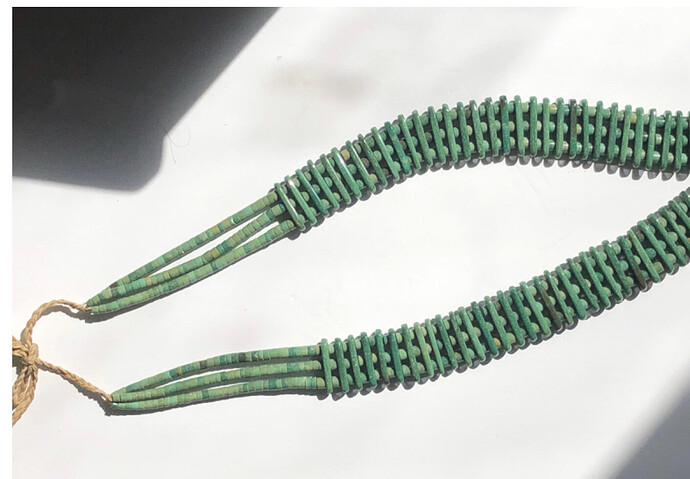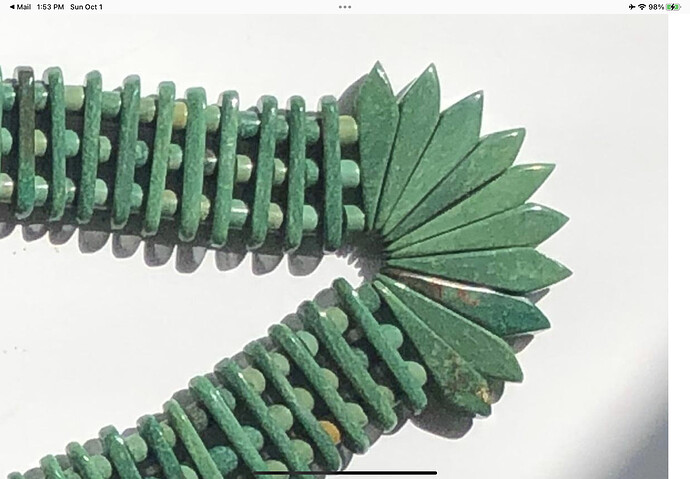I just won this on line. I like green heisha necklaces and I really liked the looks of this one…although it doesn’t look antique and perhaps it is Asian. The turquoise looks real. I see that I was the only one that bid on this item so my suspicions perked up. They valued it at $200-400. I paid $100. Did I get snookered?
Very attractive necklace. I don’t think it’s “antique”. Does have a mid-century look to it. IMHO it looks more like variscite or jasper rather than turquoise. Still a good buy given all the work that went into it.
Oh, that’s a wonderful necklace. Truly like the beautiful green color and the design is so appealing. IMO, you did well.
Thank you and @Patina. I do like the looks of this…but was hoping it was turquoise. NTL…I will wear it. I will have DIL check out the stone with her analyzer. ![]()
I think it’s turquoise, but not 100%.sure. Maybe stabilized green Kingman ![]() But again, not very sure at all.
But again, not very sure at all.
I’ll let ya know. my daughter in law has a thermo Fischer analyzer.
I use my XRF quite often @nanc9354 .
Turquoise Group Minerals
Mineral Chemical Composition
Turquoise CuAl6(PO4)4(OH)8·4H2O
Aheylite (Fe,Zn)Al6(PO4)4(OH)8·4H2O
Chalcosiderite Cu(FeAl)6(PO4)4(OH)8·4H2O
Faustite (Zn,Cu)Al6(PO4)4(OH)8·4H2O
Planerite Al6(PO4)2(OH)8·4H2O
I would check out geology.com after you use the XRF. There could be several minerals with only Al, Cu, and P. I’ll be interested in the elemental analysis.
According to mindat.org the following minerals only contain Al, Cu, and P (detectable with XRF).
Sieleckiite Cu3Al4(PO4)2(OH)12 · 2H2O
Turquoise CuAl6(PO4)4(OH)8 · 4H2O
Zapatalite Cu3Al4(PO4)3(OH)9 · 4H2O
Oh my…are you a chemist? I don’t know if her analyzer is that involved. It’s probably not the expensive TMO one. We’ll see. So in order to be turquoise…it should have aluminum, copper and phosphorus? the copper. (iron…just read that…lol) is what turns the turquoise green…right? that Geology.com is a cool site. I’m going to explore! thanks.
Higher amounts of copper are said to give turquoise more blue (think copper sulfate) and iron more green. There can also be trace amounts of Zn. That being said, this is my general knowledge based on heresay from others. I have never taken the time to actively research it and can not supply industry references to support the veracity of these claims although it sounds reasonable based on the matrix found associated in turquoise.
Depending on the sensitivity of the XRF you should be able to determine major elements vs minor ones. And you need to take several measurements from different areas of the rock. Ideally, a more reliable reading is obtained from a pulverized sample which in this case you want to avoid. Hopefully she has the All Test Geo and Cu/Zn mining library in the XRF. And the round beads should be tested also as they appear different and more like a green turquoise.
There are a lot of possibilities and might prove inconclusive. The important thing is that you found a wonderful piece at a reasonable price.


